By Kelly Carlton, Princeton University
The “Basic Patterns of Text-Image/Object Relations” workshop, one of eight training sessions hosted by FROGBEAR during Summer 2021, convened virtually on May 18 and June 29, 2021. Professors Monica Zin (Leipzig University), Christoph Anderl (Ghent University), and Paul Copp (University of Chicago) lectured on three main topics: relations between Buddhist narratives’ textual and iconographic versions; the programmatic embedding of Buddhist narratives in text and image; and relations among the content, form, and use of inscribed or imaged objects. The workshop adopted a cross-regional perspective, with examples drawn from India, Gandhāra, the Tarim basin, Dunhuang, and Sichuan. Participants consisted of scholars and graduate students from a diverse range of fields, including art history, archaeology, and religious studies.
 From left: Monica Zin (Leipzig University), Christoph Anderl (Ghent University), Paul Copp (University of Chicago). Screenshot courtesy of Carol Lee (UBC Frogbear). Republished with permission.
From left: Monica Zin (Leipzig University), Christoph Anderl (Ghent University), Paul Copp (University of Chicago). Screenshot courtesy of Carol Lee (UBC Frogbear). Republished with permission.
Zin commenced the May 18 session with a lecture on Indian Buddhist art from roughly the second century BCE to the seventh century CE. She introduced several general rules about Indian Buddhist art using visual representations of the “Defeat of Māra” (P. Māravijaya) as a basis for explanation. For instance, Indian Buddhist art portrays poly-scenic narratives in a single frame by means of conflated modes of representation (G. komplettierende Darstellungsart). The Buddha, represented “aniconically” by a central symbol or empty space, is only depicted once, while surrounding characters appear in different positions to illustrate the plot’s progression. In iconographic versions of the Māravijaya, artists use a conflated mode of representation to illustrate the moment just before and right after Śākyamuni Buddha’s enlightenment: Māra is shown attacking the Buddha on one side, and resigning to his defeat on the other.
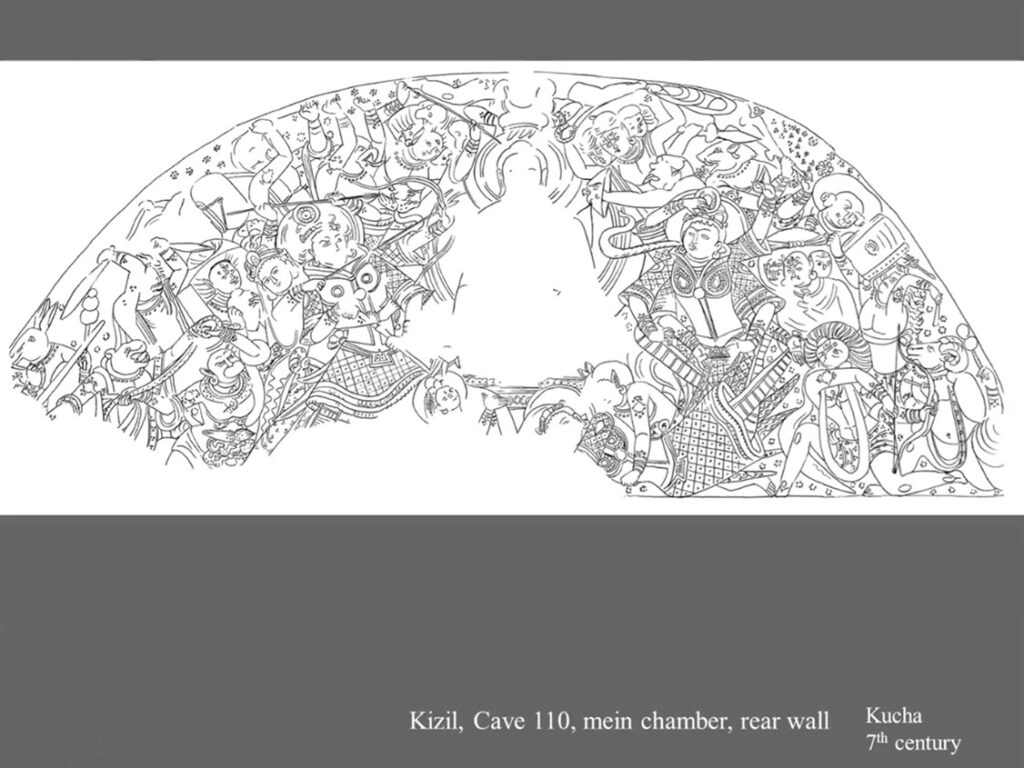

Scene of Māravijaya at Cave 110, Kizil, Kucha seventh century. Slides courtesy of Monica Zin. Republished with permission.
In the second half of her lecture, Zin demonstrated how particular textual versions of a narrative may be linked to variations in iconographic detail. In early texts, such as the Great Discourse to Saccaka (P. Mahāsaccakasutta) in the Collection of Middle-Length Discourses (P. Majjhimanikāya) and the Discourse on Striving (P. Padhānasutta) in the Collection of Discourses (P. Suttanipāta), Māra’s attack and his subsequent defeat are treated as separate narratives. With the Great Event (Skt. Mahāvastu), the two narratives are tied together and further developed; new characters, such as Māra’s daughters, appear. While narratives usually identify three daughters, Āndhra iconography of the Māravijaya depicts four. Only one textual version of the Māravijaya has four daughters: the Lalitavistara surviving in Chinese translation (Ch. Fangguang da zhuangyan jing 方廣大莊嚴經, T no. 186, 3:519). Thus, scholars may surmise that a version of the Māravijaya similar to the one preserved in the Lalitavistara served as the basis for the Āndhra image.
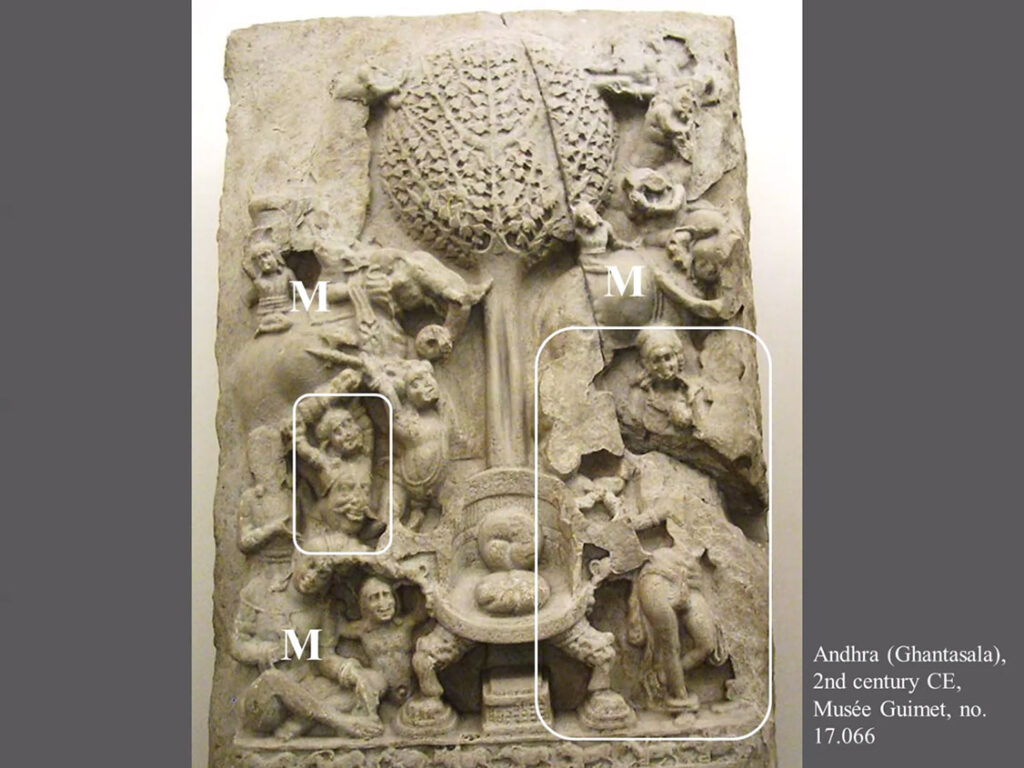
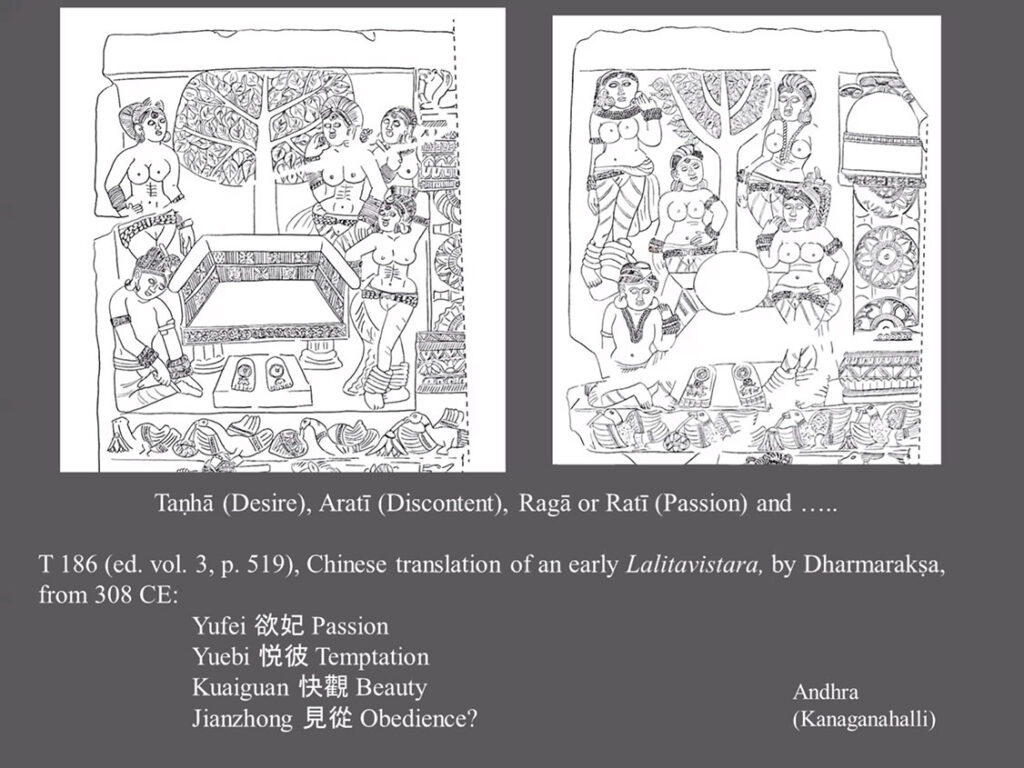
Left: Āndhra iconography of the Great Event. Right: Āndhra iconography of the Māravijaya. Slides courtesy of Monica Zin. Republished with permission.
A lively discussion followed Zin’s lecture. Questions from the audience first addressed theories of aniconism in Indian art: Were iconographic representations of the Buddha prohibited, and if so, why? In response, Zin suggested viewing the Buddha’s absence through a more positive lens. Rather than interpreting such “aniconic” representations as proscriptive, symbols or empty space may have instead been injunctions for viewers to visualize the Buddha for themselves. Another topic of discussion concerned conflated modes of representation: How does one determine if an image is mono- or poly-scenic? Zin responded that images in Indian Buddhist art are never simply snapshots, but rather records of entire narratives. Multiple representations of the same character, such as two or more Māras, point to courses of action—multiple scenes unfolding within the same frame. Discussion concluded with a query about Indian artisans’ sources. Did artisans draw more upon written texts or oral performances to create images? Zin answered that it is difficult to know, especially since Indian Buddhist images do not contain dated inscriptions like their counterparts in China.
Anderl’s lecture delved into the fascinating relationship between textual and visual representations of the Śyāmaka jātaka in China. Similar to the Māravijaya, there are disparities in detail among the Śyāmaka jātaka’s surviving textual versions. For instance, the Mahāvastu prose version is quite specific about peripheral elements, such as the names of fruits, nuts, and grains, as well as the wild animals with which Śyāmaka plays. The Mahāvastu verse version, on the other hand, concentrates on main events. The Jātakamāla of Haribhatta, for its part, provides a poetic description of the story’s natural setting. The Pāli version of the Śyāmaka jātaka is the most expanded textual version, with descriptions of the God Saka, the types of fruits and nuts eaten by Śyāmaka’s parents, and Śyāmaka’s relationship with animals. The main Chinese textual versions include independently circulated translations of the Śyāmaka jātaka (Ch. Shanzi jing 睒子經, T nos. 174–175, 3), and a variant version preserved in the Sūtra on the Collection of the Six Pāramitās (Ch. Liudu jijing 六度集經, T no. 152, 3). Chinese textual versions generally place more emphasis on peripheral elements and the virtue of filial piety. The Liudu jijing, for instance, contains a lengthy passage on Śyāmaka’s ethical attributes, while the Shanzi jing describes animals and nature in vivid detail. Chinese versions also tend to provide additional information on characters’ social circles, such as the attendants and ministers surrounding the king.
Anderl then turned to the process by which later collectanea, such as the Forest of Pearls from the Dharma Garden (Ch. Fayuan zhulin 法苑珠林, T no. 2122, 53), meaningfully condensed the Śyāmaka jātaka narrative. Sources like the Fayuan zhulin concentrate on the most central plot points and dialogues, incorporate elements from other textual versions that the compiler deemed important, and excise unessential details like characters’ emotional reactions. Some visual representations of the jātaka underwent similar processes of reduction, due to size restrictions, relief form, or position within a larger structure. In the small caves of Kizil, for instance, there is room for only the most central narrative elements. In China, the preference for wall paintings led to the development of other formats. Using the “scroll technique,” narratives could be stretched out, with several layers of overlapping scenes. In locations such as Dunhuang 敦煌, Baodingshan 寶頂山, and Maijishan 麥積山, the extended wall space allowed for the insertion of additional scenes and peripheral elements—wild animals, horses, and the king’s companions—from the Śyāmaka jātaka. A strong notion of movement is integrated into these pieces: animals are shown in flight, with a mounted hunting party in close pursuit. The scroll technique also influenced the choice to place narratives on ceilings rather than main walls. “Square” wall spaces tend to be more ideal for symmetric arrangements, like the conflated modes of representation seen in Zin’s lecture.
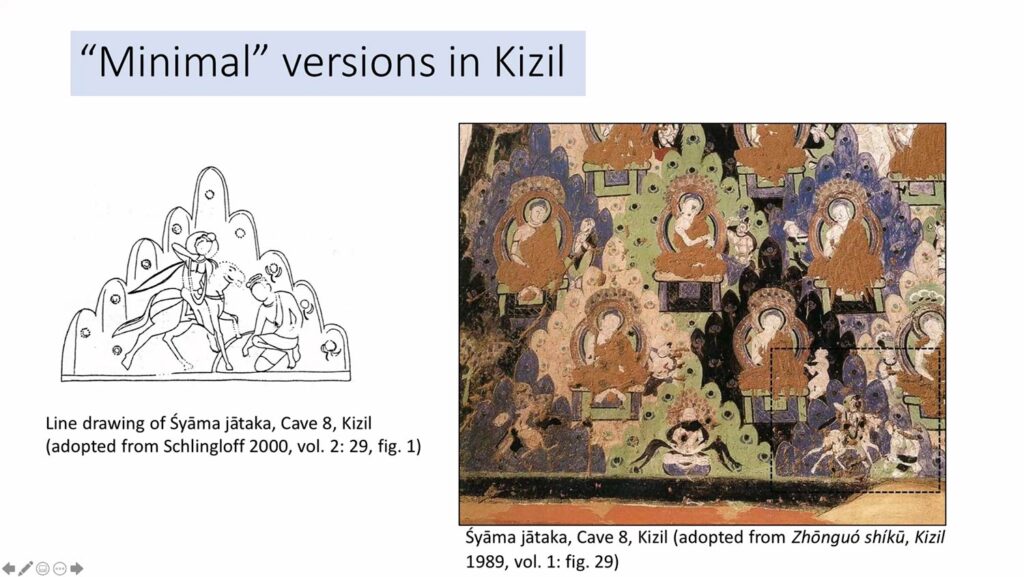
Scene from Śyāmaka jātaka at Cave 8, Kizil. Slides courtesy of Christoph Anderl. Republished with permission.
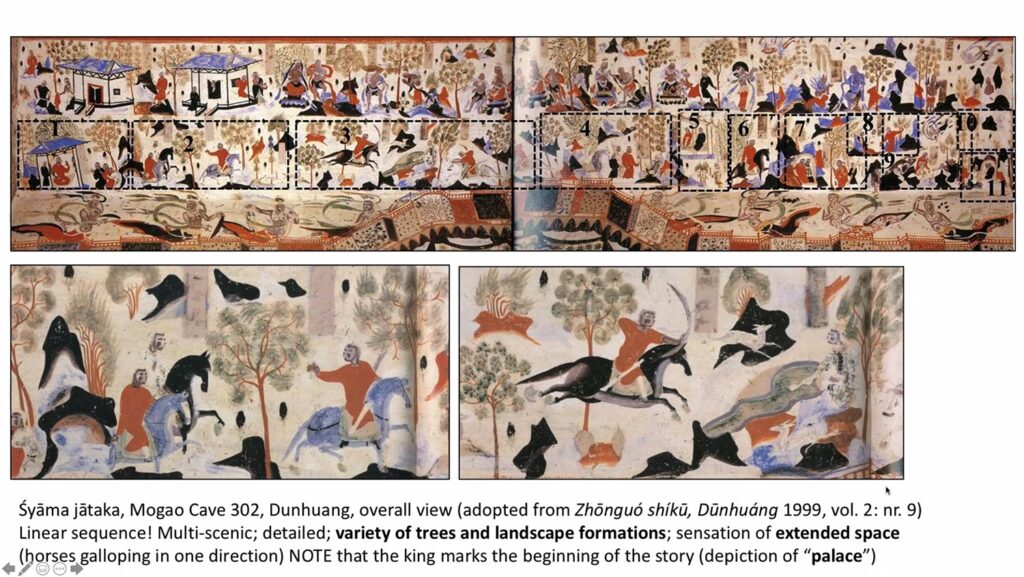 Scene from Śyāmaka jātaka at Mogao Cave 302, Dunhuang. Slides courtesy of Christoph Anderl. Republished with permission.
Scene from Śyāmaka jātaka at Mogao Cave 302, Dunhuang. Slides courtesy of Christoph Anderl. Republished with permission.Additionally, Anderl elucidated the relationship between the programmatic embedding of Buddhist narratives in text and image. The filial piety tableaux at Dunhuang and Baodingshan are excellent examples of programmatic embedding in visual form. The tableaux integrate iconographic representations of filial piety narratives from the Śyāmaka jātaka, Scripture on Repaying Kindness (Ch. Bao’en jing 報恩經, T no. 156, 3), Scripture on the Deep Indebtedness to One’s Parents (Ch. Fumu enzhong jing 父母恩重經, T no. 2887, 85), and Ullambana sūtra (Ch. Yulanpen jing 盂蘭盆經, T no. 685, 16). Interestingly, large-size textual portions of these narratives, which usually only roughly match their scriptural source, were incorporated into the tableaux, sometimes acting as a table or platform upon which the narratives are visually depicted.

Scene of filial piety tableaux at Dazu, Baodingshan. Photo by Christoph Anderl. Republished with permission.
In the subsequent discussion, Anderl addressed how individuals were meant to view such sites. In contrast to cave images, which often lacked the natural light necessary for easy observation, the filial piety tableau at Baodingshan was created to facilitate viewing: the cliffside is exposed to light and constructed at an angle so that the viewer can see higher elements. Other questions from the audience concerned the layers of interaction between text and image at Baodingshan. Anderl explained that each visual representation of a filial piety narrative is accompanied by a textual account of the story, rephrased from several scriptural sources. The tableau also incorporates the concept of time into its organization of text and image. Jātaka about the Buddha’s past lives connect to the relative present of Śākyamuni in the center, before transitioning to the relative future in the lowest parts of the tableau. A final query touched upon directions of influence: In addition to text’s impact upon image, is there evidence of images inspiring text? Anderl and Zin answered that there are cases of travelogues describing Indian-style visual products. These descriptions were then used to make images in China. However, it is difficult to determine with certainty whether text or image comes first.
Paul Copp’s lecture, “Relationships Between Images and Texts: Five Cases,” shifted from non-portable textual objects, such as text incorporated into wall paintings, to portable textual objects: manuscripts, xylographs, seals, and inscribed blocks of wood. Copp presented five separate cases to explore the following overarching question: What is the relationship between image and text, especially in terms of visual, physical, and spatial practice? In the first case, Copp discussed images that illustrate text. In a booklet of the Scripture on Guanyin (Guanyin jing 觀音經) from Dunhuang (S.6983), images depict the bodhisattva saving people from a series of perils. The images are placed at the top of the page, while the text of the scripture is positioned below. Copp prompted workshop participants to consider several questions: Why would a booklet have images illustrating the text? Is there any significance in placing image over text in this booklet? Is there any valuation built into this spatial relationship? Further, Copp encouraged participants to examine illustrations as sites of additions. Donors, for instance, may be drawn into the image, but they are not inserted into the text itself.
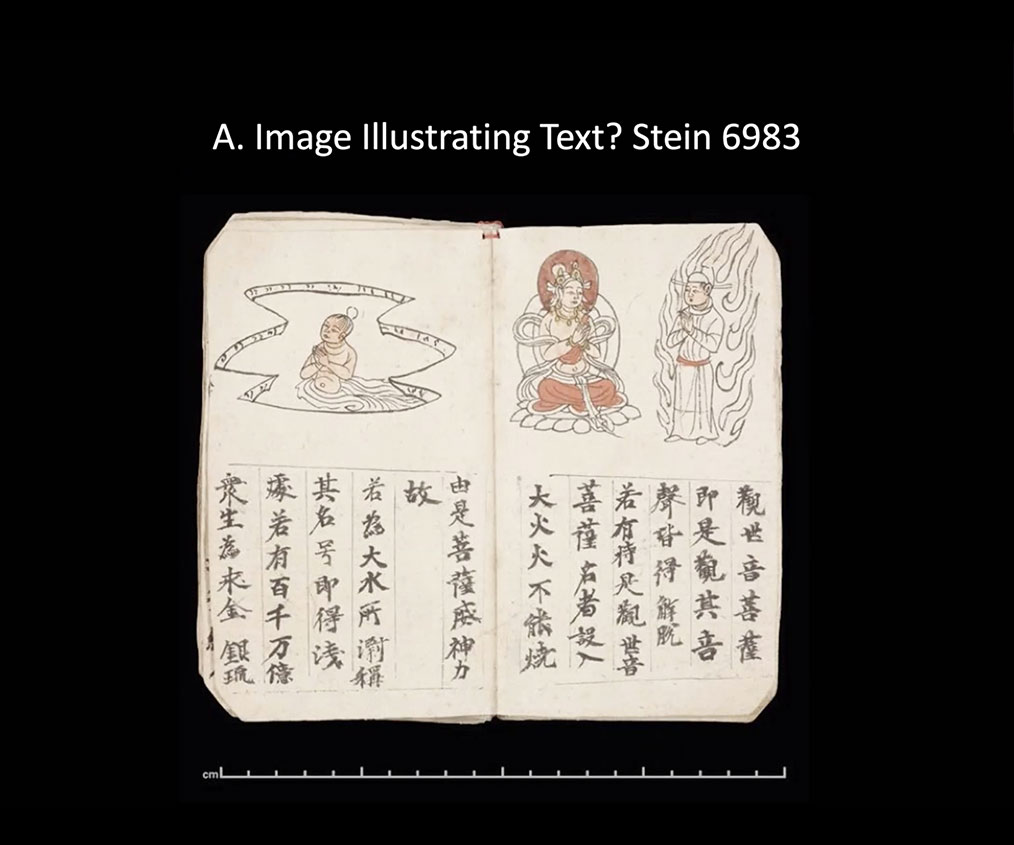
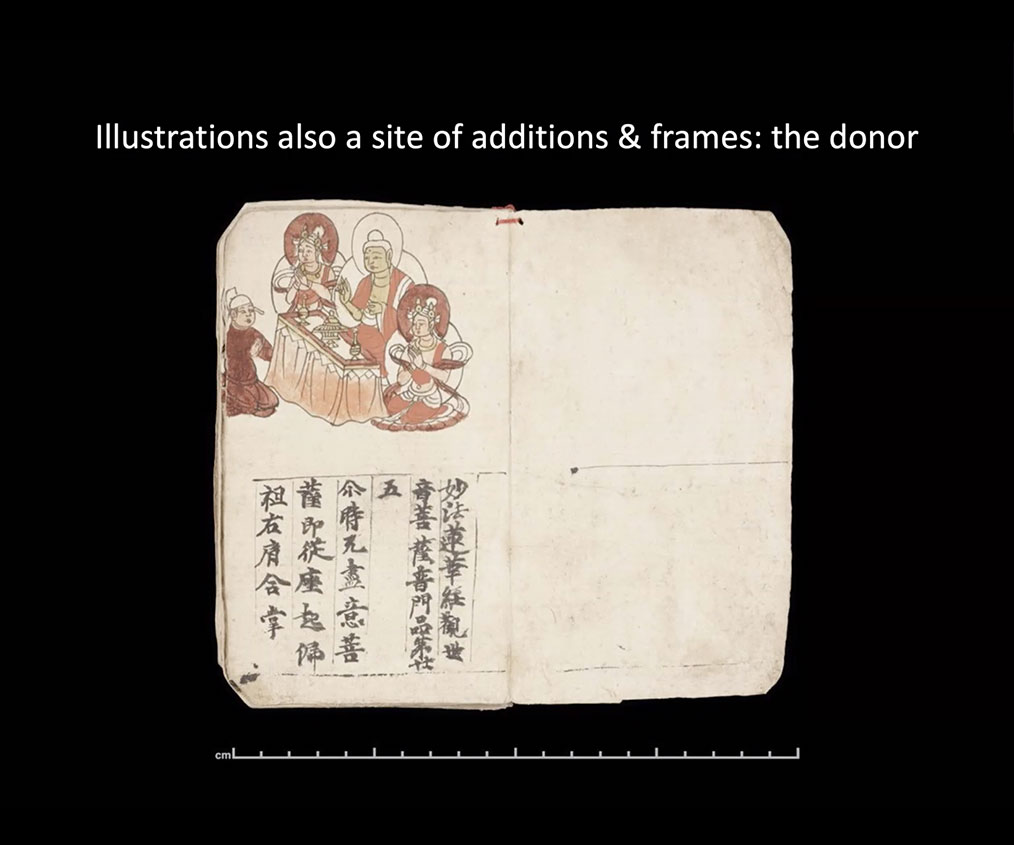
Right: illustration of donor from the same booklet. Slides courtesy of Paul Copp. Republished with permission.
The second case involved text that illustrates image, such as cartouches on paintings. In Ch.xl.008, an image of Guanyin is surrounded by depictions of the bodhisattva saving individuals from perilous situations. There are cartouches on the image where text would have been placed to explain the illustrations, although the text is missing in this case. Copp again drew attention to the spatial framing of the piece: the iconic image is placed at the top, separated spatially from the donors below. The third case addressed instances in which text is ancillary to the image, such as with icons and amulets. The manuscript S.237, for example, is a visual contemplation exercise. The image takes the dominant position, while the text—placed below the image—provides instruction. The dhāraṇī preserved in S.247 exhibits another spatial arrangement: an image encircled by Indic text is placed on the right, with Chinese text naming and explaining the image to the left. Copp explained that S.247 places emphasis not on attention or gaze, but rather on the physical manipulation of the paper. Could this account, he queried, for the image’s different spatial location? The fourth case investigated text and image working together, such as in handbooks on making and using Buddhist seals. The fifth case touched upon images that transform text, such as with performative and iconic amulets.

Ch.xl.008, Dunhuang. Slide courtesy of Paul Copp. Republished with permission.
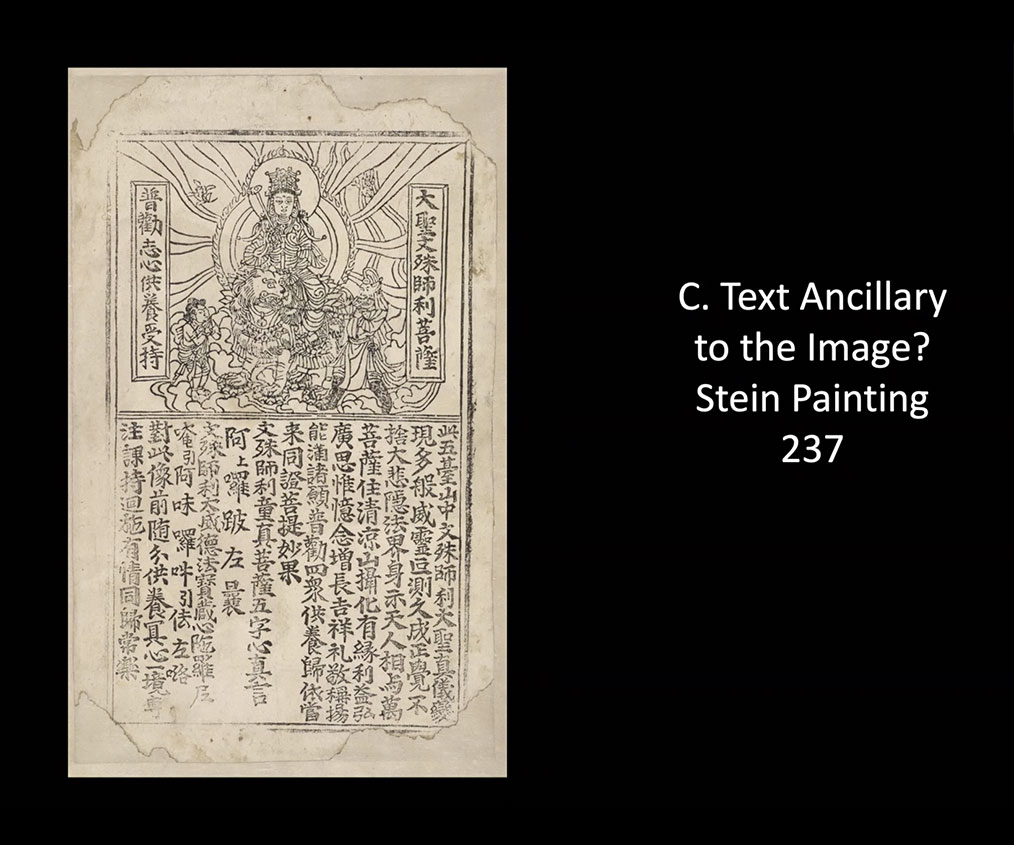
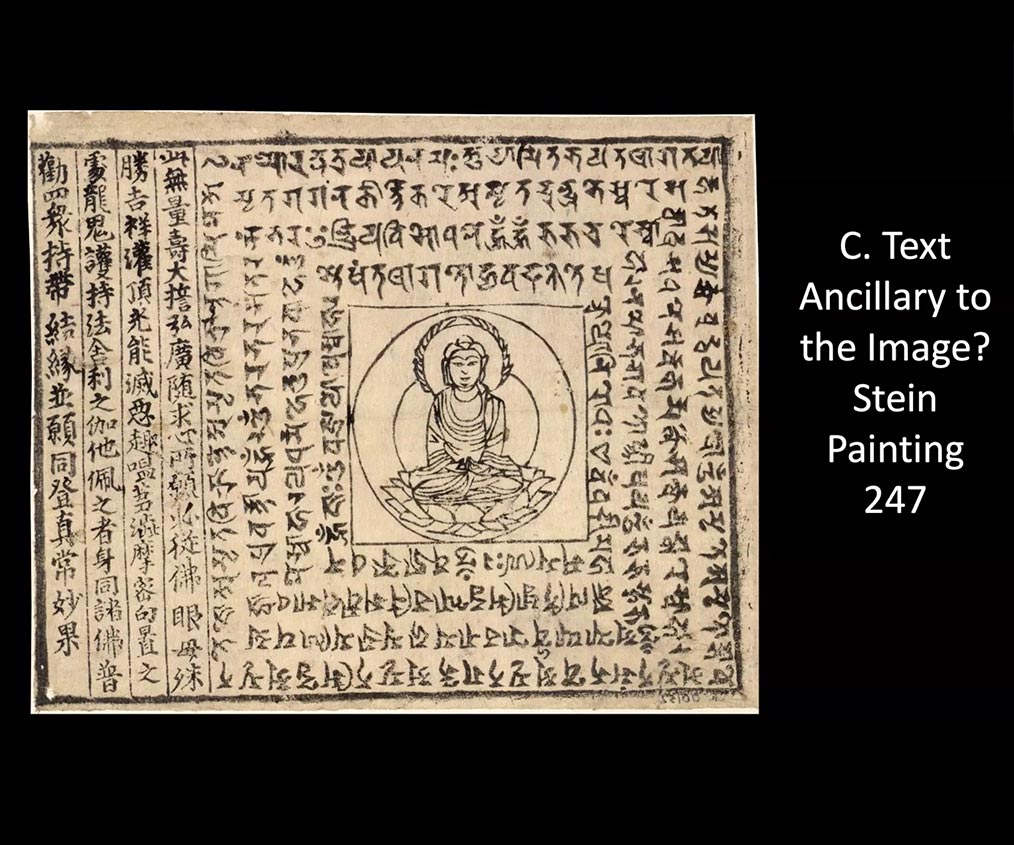
Left: S.237, Dunhuang. Right: S.247, Dunhuang. Slides courtesy of Paul Copp. Republished with permission.
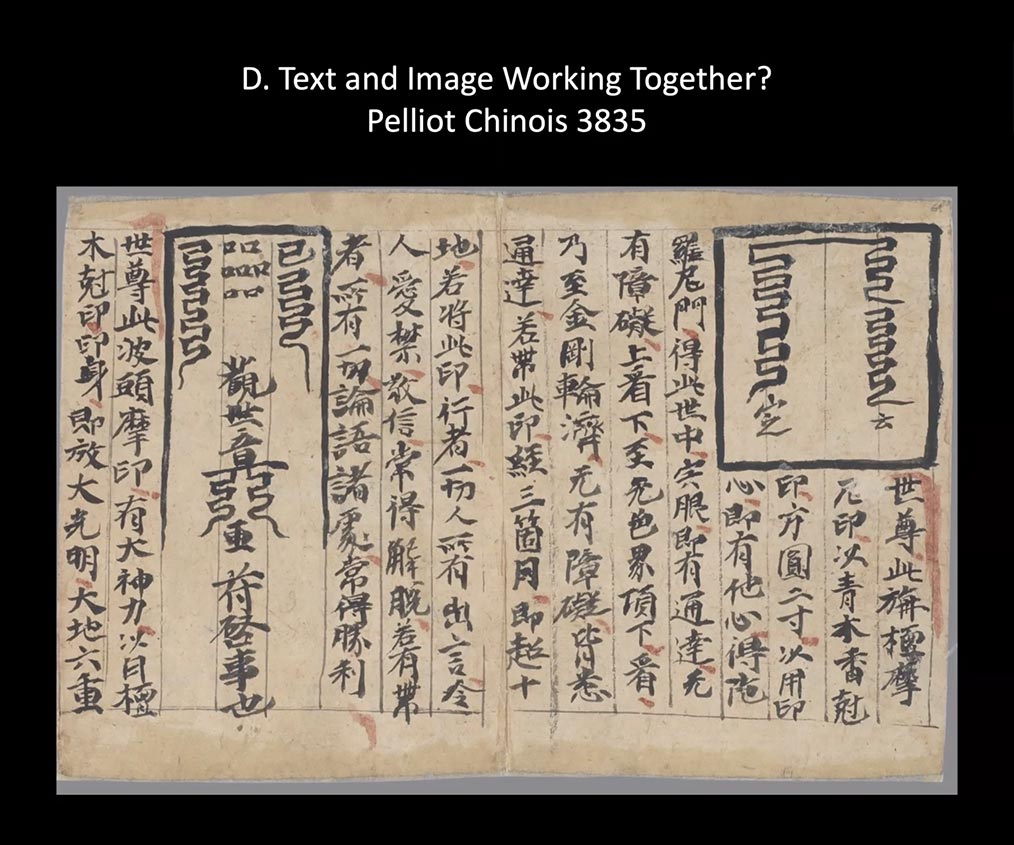
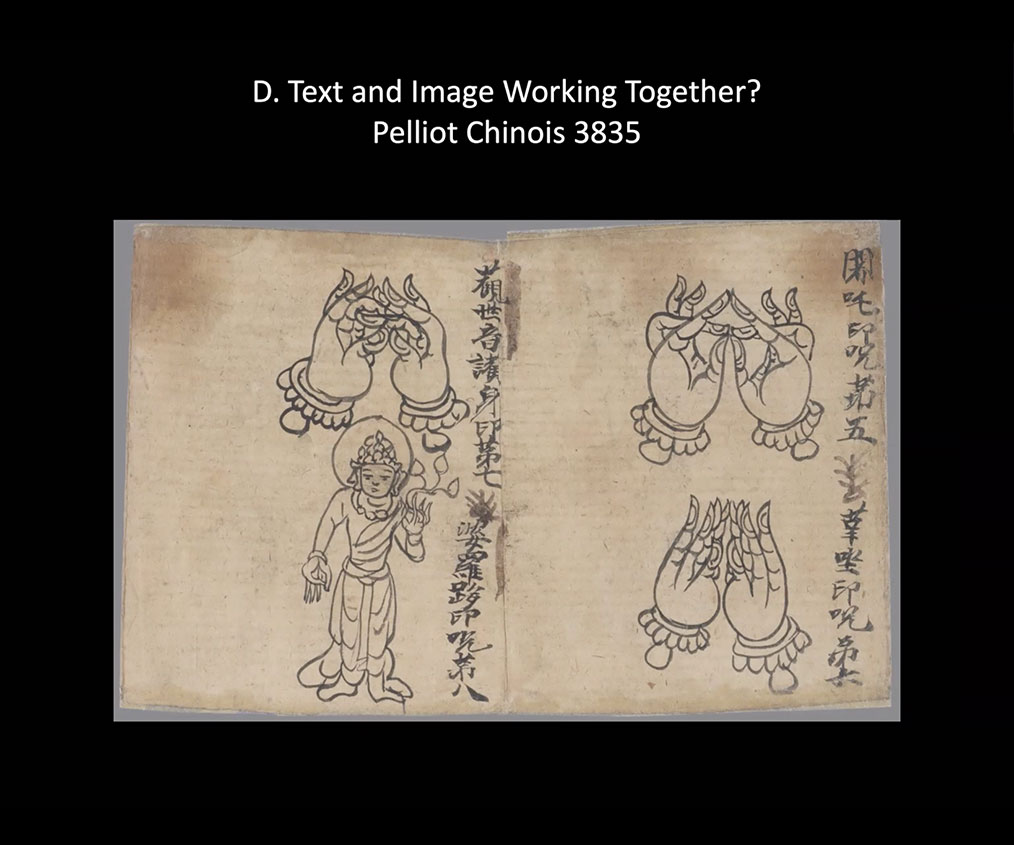
Buddhist seals from P.3835, Dunhuang. Slides courtesy of Paul Copp. Republished with permission.
Copp’s lecture prompted a vibrant discussion, which was held in a separate session on June 29. Questions included, but were not limited to, the following: Is there some kind of agent working between text and image to make the relationship functional? In the cases presented, were text and image produced at same or different times? Participants were also interested in cases in which text acts as image, such as when the text of the Heart Sūtra is written in the form of a stūpa. The session concluded with a conversation on the multiple modes of relationship that can exist between text and image within the same piece: soteriological schemes may be expressed through the directionality of figures to a central, iconic image; the arrangement of text and image may elucidate the ritual schemes that one should follow to reach this soteriological goal.

Discussion on Heart Sūtra written in the form of a stūpa. Screenshot courtesy of Vicky Baker (UBC Frogbear). Republished with permission.
The “Basic Patterns of Text-Image/Object Relations” workshop serves as an example of the dynamic conversations that are fostered from interdisciplinary approaches to Buddhist Studies. Professors Monica Zin, Christoph Anderl, and Paul Copp drew upon art historical, textual, and material culture studies to underscore patterns of influence between image and text. The participants would like to thank Zin, Anderl, and Copp for leading the workshop, Vicky Baker and Carol Lee from the University of British Columbia for administrating the workshop, and FROGBEAR for funding this series of informative summer training seminars.
Kelly Carlton is a Ph.D. candidate in Asian Religions at Princeton University. Her research focuses on children and morality in medieval Chinese Buddhism. Her dissertation examines how age, gender, and moral and biophysical development determined young Buddhist adherents’ karmic culpability, salvific agency, and participation in religious activities.
Click here to the original posting







